Themed collection organ-on-a-chip systems: translating concept into practice

Organ-on-a-chip systems: translating concept into practice
Thought leader Michael Shuler provides an update on the Lab on a Chip thematic collection organ-on-a-chip systems: translating concept into practice.

Lab Chip, 2020,20, 3072-3073
https://doi.org/10.1039/D0LC90083D
Standardisation needs for organ on chip devices
Standards can demonstrate technological and biological relevance, increase industry implementation and support regulatory acceptance. This article will give you an overview on the state of play and future needs in standardisation for OoC.

Lab Chip, 2021,21, 2857-2868
https://doi.org/10.1039/D1LC00241D
Introduction to a manuscript series on the characterization and use of microphysiological systems (MPS) in pharmaceutical safety and ADME applications
Opportunities in the drug discovery/development process for potential MPS incorporation.
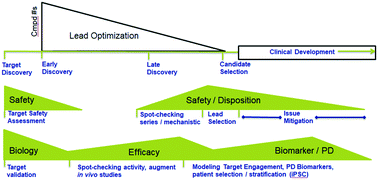
Lab Chip, 2020,20, 1049-1057
https://doi.org/10.1039/C9LC01168D
Cardiovascular microphysiological systems (CVMPS) for safety studies – a pharma perspective
The integrative responses of the cardiovascular (CV) system are essential for maintaining blood flow to provide oxygenation, nutrients, and waste removal for the entire body.

Lab Chip, 2021,21, 458-472
https://doi.org/10.1039/D0LC01040E
Application of microphysiological systems in biopharmaceutical research and development
In this review, we describe some of the advances made for tissue-specific microphysiological systems and outline the advantages and challenges of applying and further developing MPS technology in preclinical biopharmaceutical research.

Lab Chip, 2020,20, 697-708
https://doi.org/10.1039/C9LC00962K
Microphysiological systems for ADME-related applications: current status and recommendations for system development and characterization
Potential applications of MPS in the ADME discipline.

Lab Chip, 2020,20, 446-467
https://doi.org/10.1039/C9LC00857H
Drug-induced skin toxicity: gaps in preclinical testing cascade as opportunities for complex in vitro models and assays
Selected skin MPS features desired to advance further adoption within the pharmaceutical industry.

Lab Chip, 2020,20, 199-214
https://doi.org/10.1039/C9LC00519F
Microphysiological lung models to evaluate the safety of new pharmaceutical modalities: a biopharmaceutical perspective
Drug developers seek specific advancements in the development and qualification of microphysiological lung models for the evaluation of drug safety; here these essential elements are discussed from the perspective of the biopharmaceutical industry.

Lab Chip, 2019,19, 3152-3161
https://doi.org/10.1039/C9LC00492K
Developing in vitro assays to transform gastrointestinal safety assessment: potential for microphysiological systems
Drug-induced gastrointestinal toxicities (DI-GITs) are among the most common adverse events in clinical trials.

Lab Chip, 2020,20, 1177-1190
https://doi.org/10.1039/C9LC01107B
A pharmaceutical industry perspective on microphysiological kidney systems for evaluation of safety for new therapies
The human kidney contains approximately one million nephrons.
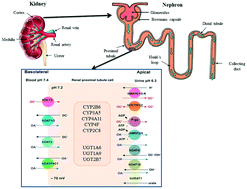
Lab Chip, 2020,20, 468-476
https://doi.org/10.1039/C9LC00925F
Liver microphysiological systems development guidelines for safety risk assessment in the pharmaceutical industry
This pharmaceutical industry guidance based on a 3-staged benchmarking strategy aims to help MPS developers and end users identify what could be the most valuable models for safety risk assessment, as well as provide an overview of contexts of use.
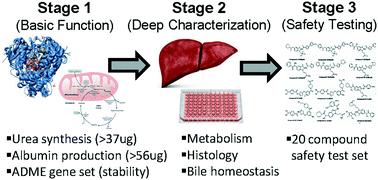
Lab Chip, 2020,20, 215-225
https://doi.org/10.1039/C9LC00768G
Exploration and application of a liver-on-a-chip device in combination with modelling and simulation for quantitative drug metabolism studies
Microphysiological systems (MPS) are complex and more physiologically realistic cellular in vitro tools that aim to provide more relevant human in vitro data for quantitative prediction of clinical pharmacokinetics while also reducing the need for animal testing.

Lab Chip, 2022,22, 1187-1205
https://doi.org/10.1039/D1LC01161H
An in vitro vascularized micro-tumor model of human colorectal cancer recapitulates in vivo responses to standard-of-care therapy
VMTs recapitulate in vivo drug responses and also reconstitute the cellular diversity of tumors.
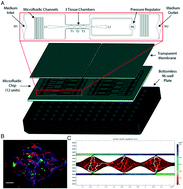
Lab Chip, 2021,21, 1333-1351
https://doi.org/10.1039/D0LC01216E
A microphysiological early metastatic niche on a chip reveals how heterotypic cell interactions and inhibition of integrin subunit β3 impact breast cancer cell extravasation
Our microfluidic model of early metastatic niche reproduced the extravasation of breast cancer cells in presence of immune blood cells and allowed us to test the effect of an already approved inhibitor of integrin β3 on cancer cell extravasation.
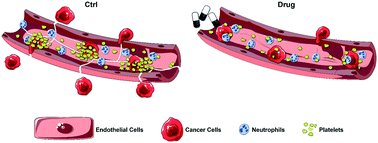
Lab Chip, 2021,21, 1061-1072
https://doi.org/10.1039/D0LC01011A
Organotypic primary blood vessel models of clear cell renal cell carcinoma for single-patient clinical trials
Identification and testing of personalized anti-angiogenic treatments for clear cell renal cell carcinoma using patient-derived microfluidic models of normal and tumor-associated blood vessels.

Lab Chip, 2020,20, 4420-4432
https://doi.org/10.1039/D0LC00252F
Integrated human organ-on-a-chip model for predictive studies of anti-tumor drug efficacy and cardiac safety
In a novel, integrated platform, integration of human bone tumor and cardiac tissues improved predictive accuracy of linsitinib efficacy and safety. This platform mimicked clinical trial results, unlike other pre-clinical models.
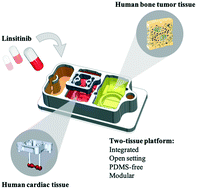
Lab Chip, 2020,20, 4357-4372
https://doi.org/10.1039/D0LC00424C
Multiplexed blood–brain barrier organ-on-chip
The developed multiplexed chip contains 8 channels that can be accessed individually or simultaneously with increased throughput. The visual inspection of cells in the device was improved with our fabricated 2 μm-thick porous PDMS membrane.

Lab Chip, 2020,20, 3132-3143
https://doi.org/10.1039/D0LC00399A
HepaChip-MP – a twenty-four chamber microplate for a continuously perfused liver coculture model
HepaChip-MP: a 24-culture-chamber, automated microfluidic in vitro model of the liver sinusoid in multiwellplate format.

Lab Chip, 2020,20, 2911-2926
https://doi.org/10.1039/D0LC00357C
An integrated biomimetic array chip for high-throughput co-culture of liver and tumor microtissues for advanced anticancer bioactivity screening
An integrated biomimetic array chip (iBAC) enables co-culture of three-dimensional (3D) liver and tumor microtissues for anticancer bioactivity screening at throughputs.

Lab Chip, 2020,20, 2482-2494
https://doi.org/10.1039/D0LC00288G
Matrix density drives 3D organotypic lymphatic vessel activation in a microfluidic model of the breast tumor microenvironment
Lymphatic organotypic in vitro model allows the examination of components of the tumor microenvironment (e.g., ECM density, cancer cells) in lymphatic vessel biology in the context of cancer, providing insights into potential therapeutic targets.
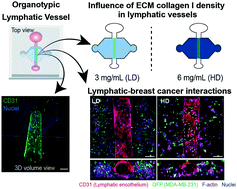
Lab Chip, 2020,20, 1586-1600
https://doi.org/10.1039/D0LC00099J
Applications of the microphysiology systems database for experimental ADME-Tox and disease models
The Microphysiology Systems Database (MPS) is a critical tool for the design, management, analysis, and sharing of MPS study data.

Lab Chip, 2020,20, 1472-1492
https://doi.org/10.1039/C9LC01047E
Monitoring tissue-level remodelling during inflammatory arthritis using a three-dimensional synovium-on-a-chip with non-invasive light scattering biosensing
We demonstrate that the integration of complex human synovial organ cultures in a lab-on-a-chip provides reproducible and reliable information on how systemic stress factors affect synovial tissue architectures using light scatter biosensing.

Lab Chip, 2020,20, 1461-1471
https://doi.org/10.1039/C9LC01097A
Low-cost microphysiological systems: feasibility study of a tape-based barrier-on-chip for small intestine modeling
High costs are a key challenge in “democratization” of organ-chip research. We present a low-resource barrier-on-chip based on tape, and use it to model small intestine and its response to chili peppers (capsaicinoids).

Lab Chip, 2020,20, 1212-1226
https://doi.org/10.1039/D0LC00009D
Microphysiological heart–liver body-on-a-chip system with a skin mimic for evaluating topical drug delivery
Body-on-a-chip in vitro systems are a promising technology that aims to increase the predictive power of drug efficacy and toxicity in humans when compared to traditional animal models.
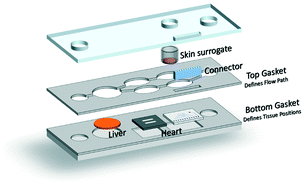
Lab Chip, 2020,20, 749-759
https://doi.org/10.1039/C9LC00861F
Kinetic analysis of sequential metabolism of triazolam and its extrapolation to humans using an entero-hepatic two-organ microphysiological system
We have constructed a mechanism-based pharmacokinetic model for triazolam and its metabolites in the entero-hepatic two-organ MPS, and extrapolated the kinetic information obtained with the MPS to the plasma concentration profiles in humans.

Lab Chip, 2020,20, 537-547
https://doi.org/10.1039/C9LC00884E
Exosome-mediated microRNA-497 delivery for anti-cancer therapy in a microfluidic 3D lung cancer model
A 3D cell culture system that mimics the lung cancer microenvironment was used to investigate the effect of exosomes encapsulating miR-497 on tumor growth and angiogenesis, and could be a predictive, cost-efficient translational tool to develop targeted cancer therapy.
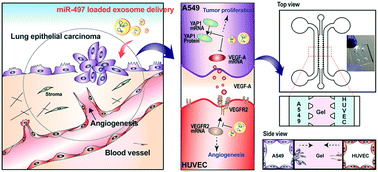
Lab Chip, 2020,20, 548-557
https://doi.org/10.1039/C9LC00958B
Organ-on-chips made of blood: endothelial progenitor cells from blood reconstitute vascular thromboinflammation in vessel-chips
Organ-on-chips made of blood: personalized medicine with microfluidics.

Lab Chip, 2019,19, 2500-2511
https://doi.org/10.1039/C9LC00469F
Self-aligning Tetris-Like (TILE) modular microfluidic platform for mimicking multi-organ interactions
Modular multi-organ perfusion systems offer the unique opportunity to customize different physiological systemic interactions.

Lab Chip, 2019,19, 2178-2191
https://doi.org/10.1039/C9LC00160C
Microfluidic assay for the on-chip electrochemical measurement of cell monolayer permeability
An electrochemical permeability assay that enables the on-chip measurement of endothelial permeability with significant advantages over traditional fluorescent tracer-based assays.

Lab Chip, 2019,19, 1060-1070
https://doi.org/10.1039/C8LC01321G
About this collection
A collection of papers and reviews on organ-on-a-chip research focussing on moving from “proof-of-principle” devices to systems that can be routinely incorporated into testing of drugs, cosmetics, food ingredients, and chemicals would be valuable to the development of the field of microphysiological systems.
This on-going collection is collated by Thought leader Michael Shuler and the Lab on a Chip Editorial Board. More details about the collection can be found at https://rsc.li/blog-organ-translation.